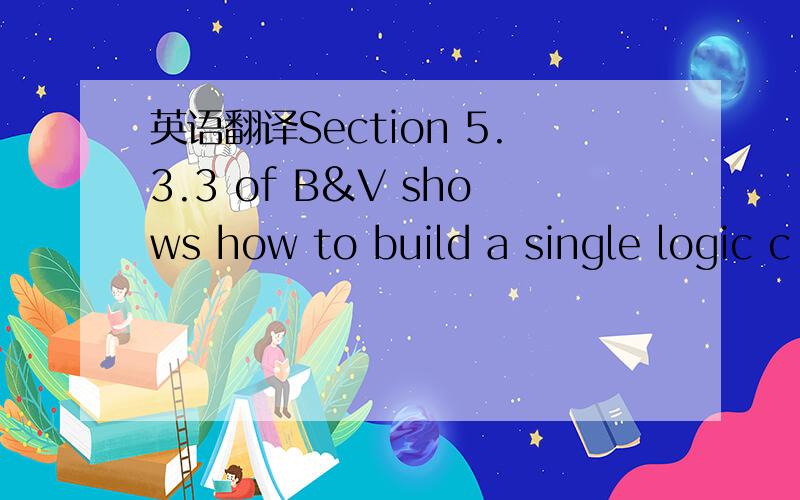英语翻译Section 5.3.3 of B&V shows how to build a single logic c
来源:学生作业帮 编辑:大师作文网作业帮 分类:英语作业 时间:2024/11/13 00:38:31
英语翻译
Section 5.3.3 of B&V shows how to build a single logic circuit that can either add or subtract,depending on a single control input.Most computer processors extend this concept much further,with logic circuits that can perform many functions.More control inputs are needed to choose from among a greater number of functions; some circuits can perform 16 functions,in which case 4 control inputs are needed.Since these functions include both arithmetic operations and simple logic,these circuits are usually called Arithmetic Logic Units,or ALUs.The ALU inside a typical processor is really the heart of the computer,in terms of actual calculation; it performs almost all of the integer calculations in the processor,even though it takes up only a tiny fraction of the chip!
In this lab,you will build a less-ambitious (but still flexible) ALU.The ALU can add,subtract,test for 0,and test equality.These functions are selected with 2 control inputs S1 and S0.Inputs A and B and output R are n-bit unsigned binary numbers and output F is a single bit.(The size n is an arbitrary positive number which is the number of bits in the integers we wish to manipulate; typical sizes range from 8 to 64 bits.)
Chapter 5 shows how to build an n-bit adder by connecting n full adders together,where the carry output of each adder connects to the carry in of the next.This is a simple example of what is called the ``bit-slice'' approach:the design is sliced into identical components,much like a loaf of bread.The slices all compute different parts of the result in parallel,and each slice may give some data to the next slice (such as a carry bit).You only need to design a single bit,and then simply hook the bits together.
For the add and subtract operations,this is the carry (or borrow) bit,necessary in addition and subtraction.For the two test operations,each 1-bit slice tests its own inputs,and if the test fails in one of the slices,that slice uses the F output to tell the slice on its left,and each slice in turn tells the next slice about this failure,until reaching the leftmost bit slice.If a slice has a 1 on its C input,that means at least one bit on the right failed the test,and this bit slice should simply pass this along by outputting a 1 on F.Otherwise,if C is 0,the bit slice should set F according to its own test.(It is a kind of OR function; the n-bit test fails if any of its bits fails.)
Section 5.3.3 of B&V shows how to build a single logic circuit that can either add or subtract,depending on a single control input.Most computer processors extend this concept much further,with logic circuits that can perform many functions.More control inputs are needed to choose from among a greater number of functions; some circuits can perform 16 functions,in which case 4 control inputs are needed.Since these functions include both arithmetic operations and simple logic,these circuits are usually called Arithmetic Logic Units,or ALUs.The ALU inside a typical processor is really the heart of the computer,in terms of actual calculation; it performs almost all of the integer calculations in the processor,even though it takes up only a tiny fraction of the chip!
In this lab,you will build a less-ambitious (but still flexible) ALU.The ALU can add,subtract,test for 0,and test equality.These functions are selected with 2 control inputs S1 and S0.Inputs A and B and output R are n-bit unsigned binary numbers and output F is a single bit.(The size n is an arbitrary positive number which is the number of bits in the integers we wish to manipulate; typical sizes range from 8 to 64 bits.)
Chapter 5 shows how to build an n-bit adder by connecting n full adders together,where the carry output of each adder connects to the carry in of the next.This is a simple example of what is called the ``bit-slice'' approach:the design is sliced into identical components,much like a loaf of bread.The slices all compute different parts of the result in parallel,and each slice may give some data to the next slice (such as a carry bit).You only need to design a single bit,and then simply hook the bits together.
For the add and subtract operations,this is the carry (or borrow) bit,necessary in addition and subtraction.For the two test operations,each 1-bit slice tests its own inputs,and if the test fails in one of the slices,that slice uses the F output to tell the slice on its left,and each slice in turn tells the next slice about this failure,until reaching the leftmost bit slice.If a slice has a 1 on its C input,that means at least one bit on the right failed the test,and this bit slice should simply pass this along by outputting a 1 on F.Otherwise,if C is 0,the bit slice should set F according to its own test.(It is a kind of OR function; the n-bit test fails if any of its bits fails.)

段B&V 5.3.3展示怎样建立一专一逻辑电路,其能要么加要么减取决于一专一控制手段投入的.绝大部分电脑处理器用原木而且得多的延长这个观念
在这个实验室中,你将建立一不那么-有抱负(更但是静止有弹性)ALU.ALU能加,减,检测0,和测验平等.这些功能随着2控制手段投入S1和S0被.投入一
在那里每一蝰蛇的射程输出连接到射程,第5章进入下一个的展示怎样通过把n完整蝰蛇连接在一起建立一条n-小块蝰蛇.这个是一什么被呼吁的简单例子
必然此外和减法.两试验运算,每一1-位份测验它的自己投入,和如果试验疏忽了份之一,那个斜击F使出的使用的在上说份
在这个实验室中,你将建立一不那么-有抱负(更但是静止有弹性)ALU.ALU能加,减,检测0,和测验平等.这些功能随着2控制手段投入S1和S0被.投入一
在那里每一蝰蛇的射程输出连接到射程,第5章进入下一个的展示怎样通过把n完整蝰蛇连接在一起建立一条n-小块蝰蛇.这个是一什么被呼吁的简单例子
必然此外和减法.两试验运算,每一1-位份测验它的自己投入,和如果试验疏忽了份之一,那个斜击F使出的使用的在上说份
Mum shows ( ) how to make a hamburger. A he B him C his D hi
英语翻译Section B 中的3a
英语翻译section b 的3a
Help~~How to build a harmonious society?
英语翻译explain how a single base deletion in the middle of a ge
四级分数计算听力section b 错两题,section c 错一题 精读section a 错一题 section
英语翻译explain how a single base change in a gene can lead to a
If a teacher really shows the students the ability of how to
英语翻译翻译下文How to Build a SnowmanBuilding a snowman provides an
A:How did the Chinese people do the work to build the wall?B
英语翻译以In your opinion how to build a lasting friendship?为题目写英
He _____ a map of the city. A shows B has C draws D gives